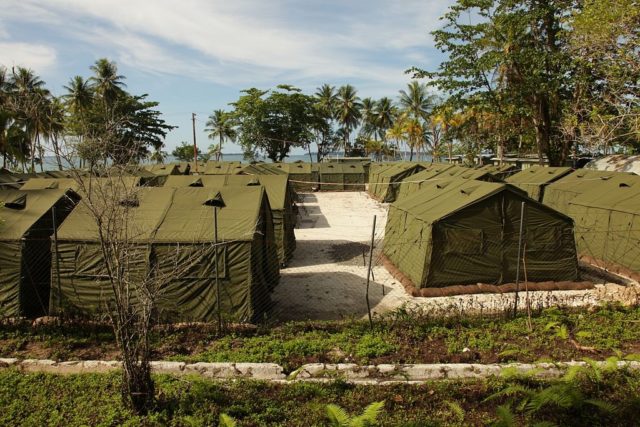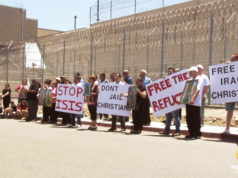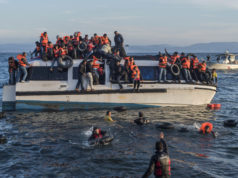
It is hard to complain about Australia — democratic, sunny, cheerful, and oh, those koalas and kangaroos. On a more serious note, Australia is a welcome ally, participating in military operations around the world with American forces and sharing our concerns about aggressive Chinese behavior in the South- and East China Seas. Australia is spending billions to modernize its military forces.
But a few things about Australia should be made clear as President Trump scuttles an Obama-administration deal to take 1,250+ refugees currently in Australian-run internment camps in Papua New Guinea and Nauru. Internment camps? Papua New Guinea and Nauru?
The Wall Street Journal explains:
“Under laws first put in place in 2001, successive Australian governments have required asylum seekers coming by boat to be intercepted. The conservatives, on winning power in 2013, set up a maritime blockade that Mr. Turnbull has offered as a model for Europe. But the system began to unravel after Papua New Guinea’s highest court last year ordered the closure of the Australian-operated immigration center on Manus Island, ruling asylum seekers were being held illegally.”
So chipper Australia has been intercepting ships at sea and dropping the passengers off on less well-developed islands. They are mostly men from Myanmar (Rohingya Muslims), Malaysia, Iran, Iraq, Afghanistan, Pakistan and Somalia, although there some women and children. The Los Angeles Times further explains:
“The refugees are the collateral damage in Australia’s widely criticized “Stop the Boats” policy, the rule that asylum seekers who try to reach Australian shores by sea will never “make Australia home,” even if they are genuine refugees, are children or have skills. “If you come to Australia illegally by boat, there is no way you will ever make Australia home,” an Australian army chief warned in a 2014 video aired online and on television in countries such as Iran, Afghanistan, Pakistan and Sri Lanka.”
Australia does take thousands of refugees each year under official programs. J. Weston Phippen wrote in The Atlantic:
“To be sure, it’s not that Australia has an issue with refugees–in fact, it has agreed to resettle 12,000 Syrians, atop the refugees it typically takes through its Humanitarian Programme. It granted 13,800 refugee visas between 2013 and 2014, and 20,000 between 2012 and 2013.
But the arrivals by sea seem to prompt anger. One reason for this could be that migrants and refugees who try to reach Australia by sea are, in fact, coming illegally. Those that are being resettled through its Humanitarian Programme, meanwhile, are registered refugees being accepted under Australia’s international obligations. The two main parties also contend that its policies deter human-smuggling.”
So off they go to Nauru and Manus.
Out of sight, perhaps out of mind until the UN documented serious problems in the camps, including physical, emotional and sexual abuse. The Guardian (Australia) published a series last summer on abuses at the Manus camp, following the leak of more than 2,000 “incident reports” detailing “assaults, sexual abuse, self-harm attempts, child abuse and living conditions endured by asylum seekers held by the Australian government, painting a picture of routine dysfunction and cruelty.” Although children make up only 18% of those in detention, more than 51% of the incident reports involve children.
Cases of depression and self-harm are high; two people set themselves on fire last year, one of whom died, and one girl swallowed bleach. Many have reported that the biggest problem is the sense of paralysis at being trapped in limbo indefinitely, according to Tracey Donehue, a former teacher at one of the facilities interviewed by the Los Angeles Times.
Following the very unpleasant exposure, the government of Malcolm Turnbull announced in August 2016 that it would close one center on Manus Island, but would bring none of its internees – 854 adults, all men – to the Australian mainland, raising the question of what to do with them. Australia’s Immigration Minister, Peter Dutton, said Canberra’s “position is very clear, and that is we are not going to accept people who have sought to come to our country illegally by boat, they will not settle permanently in our country.”
Enter President Obama.
In September, Turnbull agreed to resettle Central American refugees who were in a processing center in Costa Rica. At the time, Australian officials said firmly there would be no quid pro quo. “There will not be a people swap,” announced Scott Ryan, a special minister of state. The American agreement to take Australian internees came two months later, providing a convenient way for Mr. Turnbull to keep his promise to his people and get rid of people who had become a public relations disaster.
Then-Secretary of State John Kerry worked out the deal with Australia to “fast track” the immigrants, but did not tell Congress. In November, responding to information it received, WND reported that the chairmen of the House and Senate judiciary committees demanded details:
“Congress only learned of the deal through media reports two weeks ago [November, 2016] and – according to a letter sent to administration officials by Sen. Chuck Grassley (R-Iowa), and Rep. Bob Goodlatte (R-Va.) – the deal is not only a matter of grave national security concern, but it could be illegal.”
It would be illegal if the deal was considered a treaty negotiated by then-Secretary Kerry. According to the Constitution, it would have to have been sent to Congress for ratification.
Asked if he had discussed the deal with then-candidate Donald Trump, Turnbull said, “We deal with one administration at a time and there is only one president of the United States at a time.” But Donald Trump is now president and his decision appears to have left the Australian government with few choices.
Asked if there was a “Plan B” for Australia, Turnbull said he was examining several options, but that Australia would not back down on its decision not to let those refugees stopped at sea enter the country:
“Our expectation naturally, given the commitments that have been made, is that it will go ahead. The only option that isn’t available to [the refugees] is bringing them to Australia for the obvious reasons that that would provide a signal to the people smugglers to get back into business.”
Whether there is an agreement to be had between the United States and Australia for the resettlement of Australia’s interned population or not, it is clear that this deal had more to it than the Obama Administration — or the Turnbull government — wanted to admit. The United States and Australia both had reasons not to admit the migrants closest to their borders, but trading Central Americans who wanted to come to the U.S. for Muslims who wanted to reach Australian shores would allow Turnbull to keep a campaign promise and Obama to divert attention from the massive breach of America’s southern border.





